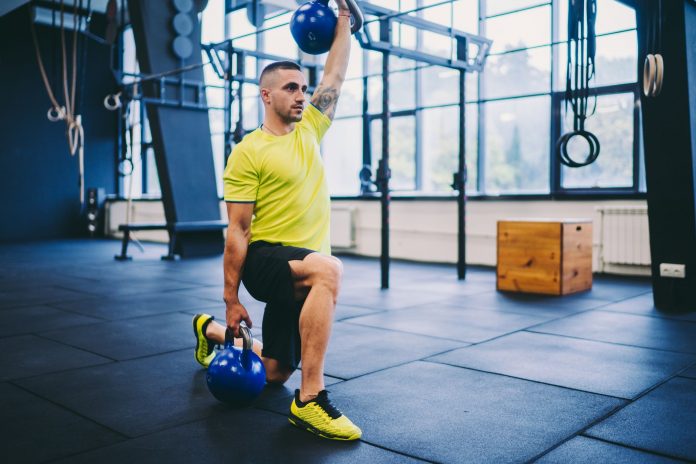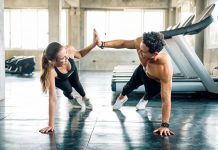How to fit stability work into your routine—and why you should
With you exercise, you may focus on how certain regimens will improve your strength, help you lose weight, or even make you more flexible. Or maybe you just exercise to feel good and stay healthy—all are valid motivations for breaking a sweat. But another huge benefit of exercise you may not think about is how it improves your balance.
Working on your balance, or stability, won’t just make you look more graceful in the weight room (though that’s a welcome perk). “Improving balance is important for overall fitness and everyday activities simply because it increases overall movement function,” Robbie Ann Darby, an ACE-certified personal trainer in New York City, tells SELF. Any workout move you do requires some level of balance—to even just walk you need to have basic balancing abilities.
The core is often referred to as the powerhouse of your body. It’s also your balance center. Having a strong core allows you to control your body’s positioning and maintain an upright position. Your back and chest play a role here, too. All of these muscles are important for both posture and stability. But purposefully training your body to move in new ways that disrupt and challenge your balance will also help tremendously.
When you do exercises that throw off your center of gravity—like holding one leg up in the air while doing a bicep curl—your body and brain have to work overtime to keep you stable. “Basically anything that challenges your center of gravity will improve your balance,” Darby says. “This can include lifting and holding one or more of your extremities at a time and/or the use of props such as weights or unstable surfaces such as Bosu balls.” Balance work is also great for bodily awareness. “Having to focus mentally during these type of exercises impacts your ability to have a mind-body connection in your workouts,” Darby says, which can also carry over to everyday activities outside of the gym.
The best way to use these balance-based moves? Choose a few to add to your warm-up. “Warming up with exercises like this is a great way to activate your core and mentally prepare you for the workout to come, since balance requires a significant amount of mental focus,” Darby adds. “As a former dancer and athlete, I incorporate balance into all of my workouts,” she adds. “However, no matter your workout level or goals, incorporating balancing exercises into each of your workouts or warm-up routines is ideal for an overall balanced (pun intended) fitness regimen.”
Ready to start? Below, Darby demos seven exercises that are great for challenging and improving your balance skills.
Sumo Squat With Outer Thigh Pulse
Start in a wide stance, feet turned out 45 degrees.
Bend at your knees and hips to lower into a sumo squat. Keep your torso upright.
As you stand, extend one leg and the opposite arm. Hold and pulse your leg up 2 to 3 inches three times.
Put your leg back down to start position and repeat.
Alternate sides for 12 reps.
“This exercise strengthens your lower body and forces the core to engage while improving your balance,” Darby says. To make this move harder, she suggests holding a weight or a medicine ball using the arm that isn’t extended.
Standing Crunch With Under-the-Leg Clap
Start balancing on one leg, with the other out in front of you, knee bent at a 90-degree angle, and your hands together overhead.
Crunch forward and clap your hands under the raised leg.
Continue to clap over your head and under your raised leg 12 times. Repeat on your other leg.
“Balancing on one leg is challenging in itself. Add movement in the midst of a static hold with these claps and your core will be on fire,” Darby says. To make this harder, hold light to medium weights. To make it easier, lower your leg to the ground when you clap overhead.
Curtsy Lunge With Oblique Crunch
Stand with your feet hip-width apart, fingertips at your ears and elbows out wide.
Cross one leg behind you and lower into a curtsy lunge.
Without rotating your hips, stand and bring that same leg up to meet the same side elbow for an oblique crunch.
Do 12 reps, and then switch legs.
“This total-body movement activates the glutes, engages the inner thigh, and strengthens your obliques,” Darby says. To make this harder, hold light to medium weights. To make it easier, alternate sides.
Plank With Flying Plane Arms
Start in high plank with your arms extended and hands directly under your shoulders.
Keep your hips stable and core engaged as you lift one arm straight out in front of you.
Keep holding this arm up and fan it out to the side.
Return your hand to the front again, then lower it to the ground.
Repeat this sequence on the opposite side. Continue to alternate sides for 12 rounds.
“By lifting and mobilizing one of your extremities both your core strength and stability are challenged,” Darby explains. To make this harder, bring your feet closer together. To make it easier, open your feet wider or do the sequence on all fours.
Rolling Forearm Side PlankStart in a side forearm plank, propping up your body weight on your forearm. Stack your feet on top of each other. Extend the top arm.Roll under your body to the opposite side, switching which arm is on the ground and which is in the air.Hold on each side for 2 to 3 seconds.Continue to roll from side to side 12 times.Darby explains that the movement of rolling from one side of your body to the other challenges your balance as your body moves between creating momentum and stabilizing in a static hold. To make this harder, lift the top leg before rolling to the opposite side. To make it easier, place your bottom knee on the ground.
Arm Sequence With Lifted Heels
Start standing with your feet together, knees pressing in toward each other and slightly bent, holding a pair of light to medium dumbbells with your arms relaxed by your sides.
Lift your heels off the floor about 2 inches. Hold this posture as you do a bicep curl and shoulder press. With your arms extended, lower the weights back to the starting position.
Keep your core engaged throughout the move to prevent arching your back.
Repeat the sequence eight times.
“By standing in a narrow stance and having your heels lifted, your center of gravity is naturally unstable,” Darby says. By adding moving arms on top of that, your core strength and balance are further challenged. To make this harder, bend the knees deeper and/or choose heavier weights. To make it easier, lower your heels in between each arm movement, and/or ditch the weights.
T-Stand With Hinge and Side Bend
Start balancing on your left leg with your right knee bent at a 90-degree angle, hands extended out to the side.
Hinge at your hips, tighten your core, and raise your right leg out behind you. As you do, lower your torso and reach your right hand to touch the inside of your left ankle.
Return to start. Then reach your right hand down to touch the outside of your right leg.
Complete the sequence eight times on one side. Repeat on your opposite side.
“By balancing on one leg while moving through various planes of motions, your core muscles are strengthened and your balance is challenged,” Darby says. To make this harder, keep your arms extended out to the sides and hold medium to heavy weights. To make it easier, tap the raised leg to the floor in between the hinge and the side bend.

























